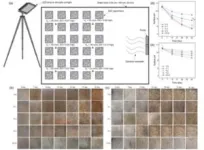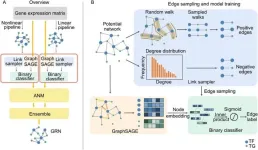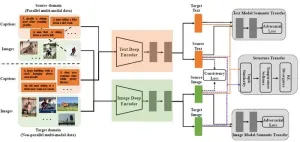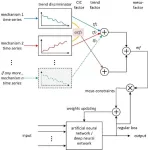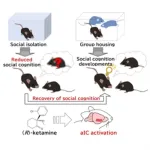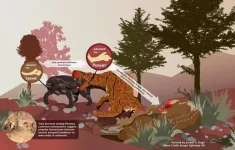(Press-News.org) Whiteflies, particularly the African cassava whitefly (Bemisia tabaci, SSA1-SG1), pose a significant threat to agricultural productivity in Sub-Saharan Africa by transmitting viruses that cause cassava brown streak disease and cassava mosaic virus disease. In a new study published in PeerJ Life & Environment, Dr. Tadeo Kaweesi and his team at the National Agricultural Research Organization identify potential gene targets that could revolutionize the management of this devastating pest and prove vital for food security in the region.
In the article ("In silico prediction of candidate gene targets for the management of African cassava whitefly (Bemisia tabaci, SSA1-SG1)"), the researchers describe utilizing advanced computational methods to pinpoint genes crucial for osmoregulation and symbiosis within the gut and bacteriocytes of the cassava whitefly. By comparing gene expression profiles through RNAseq analysis and conducting phylogenetic and metabolic reconstruction analyses, the team identified seven critical gene targets with enriched expression in the target organs.
The study highlights three osmoregulation genes - AQP1, SUC1, and SUC2 - involved in sucrose hydrolysis and water cycling, and four symbiosis genes argH, lysA, BCAT, and dapB - essential for amino acid biosynthesis pathways. These genes play key roles in regulating physiological processes vital for the survival of cassava whiteflies.
The identification of these gene targets opens up new avenues for the development of novel management strategies against cassava whiteflies. By targeting these genes, the aim is to not only reduce direct feeding damage but also mitigate the spread of viral diseases, ultimately safeguarding food security for millions in Sub-Saharan Africa.
The next steps involve further evaluation of the impact of targeting these genes, individually or in combination, on the development and survival of B. tabaci. The most effective gene or gene combination will be integrated into transgenic plants for use in comprehensive whitefly management programs in cassava-growing regions.
For more information about this research, the full article can be accessed at PeerJ.com
END
New study identifies potential gene targets for management of cassava whitefly, key vector of viral diseases threatening African food security
2024-02-23
ELSE PRESS RELEASES FROM THIS DATE:
Twin, the new robotic exoskeleton for lower limbs
2024-02-23
Milan (Italy), 23 February 2024 – TWIN is the name of the new robotic exoskeleton for lower limbs, designed and developed by Rehab Technologies IIT – INAIL, the joint laboratory between the Istituto Italiano di Tecnologia (IIT-Italian Institute of Technology) and the Prosthetic Center of INAIL (the prosthetic unit of the National Institute for Insurance against Accidents at Work), which will allow patients to wear it more easily. Presented today in Milan during a press conference held at the Museum of Science and Technology, TWIN was demonstrated ...
Mass shooting lockdown drills help schoolchildren feel safer, US study suggests
2024-02-23
Lockdown drills, practiced to help prepare children for shooting incidents at school, make those who have been exposed to violence feel safer – a new study of thousands of students in the US indicates.
The finding, reported in a new peer-reviewed paper published in the Journal of School Violence, contradicts claims that the drills traumatize children, without making them feel safer.
Ensuring that students feel safe – and are safe – in schools is essential for them to learn and thrive, explains ...
Wake-up call for us all to establish regular healthy sleeping patterns
2024-02-23
t’s official. Getting the recommended 7-9 hours of sleep a night is currently out of reach for almost one-third of the population as Flinders University experts found 31% of adults had average sleep durations outside the recommended range.
The global study of thousands of adults published in Sleep Health found only 15% of people slept the recommended 7-9 hours for five or more nights per week – and among those who did achieve an average of 7-9 hours per night over the nine month monitoring period, about 40% ...
Using mussels and silkworm cocoons to stop organ bleeding
2024-02-23
In recent news, there has been a case where a patient experienced pain due to a surgical procedure involving sutures, resulting in the unintended presence of gauze within the patient's body. Gauze is typically employed to control bleeding during medical interventions, aiding in hemostasis. However, when inadvertently left in the body, it can lead to inflammation and infection. Addressing this issue, recent research has been published by researchers focusing on a hemostatic agent derived from mussels and silkworm cocoons. This hemostatic agent has garnered attention in the academic community due to its efficacy in clotting blood and its safety within ...
New research reveals how cancer hijacks immune cells to promote tumour growth
2024-02-23
A new research study led by A*STAR.Singapore Immunology Network (A*STAR.SIgN) has found that neutrophils—one of the most abundant white blood cells in our body—change drastically in certain cancers, adopting a new function whereby they promote tumour growth. By carefully studying neutrophils as soon as they enter the tumour, scientists from A*STAR.SIgN also uncovered ways to accurately differentiate tumour-promoting neutrophils from normal neutrophils present in the rest of the body. Neutrophils play important and irreplaceable roles in fighting infections, ...
Gene regulatory network inference based on causal discovery integrating with graph neural network
2024-02-23
Gene regulatory networks (GRNs) depict the regulatory mechanisms of genes within cellular systems as a network, offering vital insights for understanding cell processes and molecular interactions that determine cellular phenotypes. Transcriptional regulation, a prevalent type for regulating gene expression, involves the control of target genes (TGs) by transcription factors (TFs). One of the major challenges in inferring GRNs is to establish causal relationships, rather than just correlation, among the various components ...
Alignment efficient image-sentence retrieval considering transferable cross-modal representation learning
2024-02-23
Image-sentence retrieval task aims to search images for given sentences and retrieve sentences from image queries. The current retrieval methods are all supervised methods that require a large number of annotations for training. However, considering the labor cost, it is difficult to re-align large amounts of multimodal data in many applications (e.g., medical retrieval), which results in unsupervised multimodal data.
To solve the problem, a research team led by Yang YANG published their new research on 15 Feb 2024 in Frontiers of Computer Science co-published by Higher Education Press and ...
A novel deep learning modeling approach guided by mesoscience—MGDL
2024-02-23
Deep learning modeling that incorporates physical knowledge is currently a hot topic, and a number of excellent techniques have emerged. The most well-known one is the physics-informed neural networks (PINNs). PINN integrates the residuals of the system’s governing partial differential equations (PDEs) and the initial value/boundary conditions into the loss function, thus the resulting model satisfies the constraints of the physical laws represented by the PDEs. However, PINN cannot work if equations among the key physical quantities of the system have not been established. To ...
Improving social symptoms of depression with a common anesthetic
2024-02-23
Osaka, Japan – Well-being is important for everyone, especially when we feel lonely or isolated. Depression is a serious challenge for many people and finding an effective solution is key.
In a recent study published in Molecular Psychiatry, researchers from Osaka University used a mouse model of depression to reveal that one form of ketamine (a common anesthetic) in low doses can improve social impairments by restoring functioning in a specific brain region called the anterior insular cortex.
Ketamine is often used at low doses to treat depression, but its actions in the brain remain relatively unclear. Generally, ketamine refers to a mix of two different forms of ketamine: ...
Killer instinct drove evolution of mammals’ predatory ancestors
2024-02-23
The evolutionary success of the first large predators on land was driven by their need to improve as killers, researchers at the University of Bristol and the Open University suggest.
The forerunners of mammals ruled the Earth for about 60 million years, long before the origin of the first dinosaurs. They diversified as the top predators on land between 315–251 million years ago.
Researchers studied the jaw anatomy and body size of carnivorous synapsids, using these traits to reconstruct the likely feeding habits of these ancient predators and chart their ecological ...


